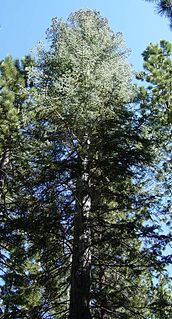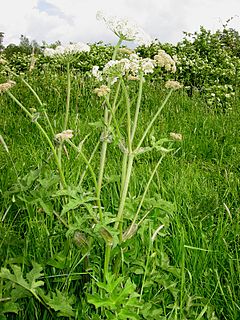
Pinus nigra, the Austrian pine or black pine, is a moderately variable species of pine, occurring across Southern Europe from the Iberian Peninsula to the eastern Mediterranean, on the Anatolian peninsula of Turkey, Corsica and Cyprus, as well as Crimea and in the high mountains of Northwest Africa.

Ceanothus is a genus of about 50–60 species of nitrogen-fixing shrubs and small trees in the buckthorn family (Rhamnaceae). Common names for members of this genus are buckbrush, California lilac, soap bush, or just ceanothus. "Ceonothus" comes from Ancient Greek: κεάνωθος (keanōthos), which was applied by Theophrastus to an Old World plant believed to be Cirsium arvense.

Abies concolor, the white fir, is a coniferous tree in the pine family Pinaceae. This tree is native to the mountains of western North America, including the Cascade Range and southern Rocky Mountains, and into the isolated mountain ranges of southern Arizona, New Mexico, and Northern Mexico. It naturally occurs at elevations between 900–3,400 metres (3,000–11,200 ft).

Encelia is a genus of the plant family Asteraceae. It consists of shrubs of arid environments in southwestern North America and western South America.

Encelia farinosa, is a common desert shrub of northern Mexico and the southwestern United States.

Heracleum sphondylium, commonly known as hogweed, common hogweed or cow parsnip, is a herbaceous perennial or biennial plant, in the umbelliferous family Apiaceae that includes fennel, cow parsley, ground elder and giant hogweed. It is native to Europe and Asia. The common name eltrot may also be applied, but is not specific to this species. Umbelliferous plants are so named because of the umbrella-like arrangement of flowers they produce. The North American species Heracleum maximum is sometimes included as a subspecies of H. sphondylium.

Encelia frutescens is a species of flowering plant in the family Asteraceae known by the common names button brittlebush and bush encelia.

Encelia californica is a species of flowering plant in the family Asteraceae known by the common name California brittlebush. It is also commonly referred to as California coast sunflower and California bush sunflower.

Encelia virginensis is a North American species of flowering plants in the family Asteraceae known by the common name Virgin River brittlebush. This shrub is native to the southwestern United States and northwestern Mexico, particularly the Mojave Desert and the Sonoran Desert. It has been found in Baja California, southern California, Nevada, Arizona, southwestern Utah, and southwestern New Mexico.
Button brittlebush may refer to one of the following flowering plants:

The Lower Colorado River Valley (LCRV) is the river region of the lower Colorado River of the southwestern United States in North America that rises in the Rocky Mountains and has its outlet at the Colorado River Delta in the northern Gulf of California in northwestern Mexico, between the states of Baja California and Sonora. This north–south stretch of the Colorado River forms the border between the U.S. states of California/Arizona and Nevada/Arizona, and between the Mexican states of Baja California/Sonora.

Condea emoryi, the desert lavender, is a large, multi-stemmed shrub species of flowering plant in Lamiaceae, the mint family.

Argyranthemum frutescens, known as Paris daisy, marguerite or marguerite daisy, is a perennial plant known for its flowers. It is native to the Canary Islands. Hybrids derived from this species are widely cultivated as ornamental plants in private gardens and public parks in many countries, and have naturalized in Italy and southern California. There are many cultivars, but the most common has white petals.

Encelia actoni, also known by the common names Acton brittlebush and Acton encelia, is a species of flowering plant in the family Asteraceae.

Eucalyptus resinifera, commonly known as red mahogany or red messmate, is a species of medium-sized to tall tree endemic to coastal areas of eastern Australia. It has rough, stringy or fibrous bark on the trunk and branches, lance-shaped adult leaves, flower buds in groups of between seven and eleven, white flowers and hemispherical, conical or cup-shaped fruit.

Populus fremontii, commonly known as Frémont's cottonwood, is a cottonwood native to riparian zones of the Southwestern United States and northern through central Mexico. It is one of three species in Populus sect. Aigeiros. The tree was named after 19th century American explorer and pathfinder John C. Frémont.

Lycium berlandieri is a species of flowering plant in the nightshade family known by the common name Berlandier's wolfberry. It is native to Mexico and the south-western United States from Arizona to Texas.
Creosote bush scrub is a North American desert vegetation type of sparsely but evenly spaced desert plants dominated by creosote bush and its associates. Its visual characterization is of widely spaced shrubs that are somewhat evenly distributed over flat or relatively flat desert areas that receive between 2 and 8 inches of rain each year. It covers the majority of the flat desert floor and relatively flat alluvial fans in the Mojave Desert, Chihuahuan Desert, and Sonoran Desert. The dominant plants that typify this vegetation type are creosote bush and its associates, white bur-sage, brittlebush, cheese-bush, Mojave yucca, silver cholla cactus, and beavertail cactus. Creosote bush has a wider range than its associates, so codominant shrubs, which are associated with more narrow ranges, will vary from region to region.
Encelia scaposa, common name onehead brittlebush is a North American species of flowering plants in the family Asteraceae. It has been found in western Texas, southwestern New Mexico, and Chihuahua.

Argyrochosma limitanea, the southwestern false cloak fern, is a species of fern native to the southwestern United States and Sonora, Mexico. It grows on calcareous rocks, and has small, finely-divided leaves with a leathery texture, dark axes connecting the leaf segments, and a heavy coating of white powder on the undersurface. It reproduces apogamously; two subspecies are recognized, which may have originated independently through the hybridization of other taxa not yet discovered. First described as a species in 1919, it was transferred to the new genus Argyrochosma in 1987, recognizing their distinctness from the "cloak ferns".
















